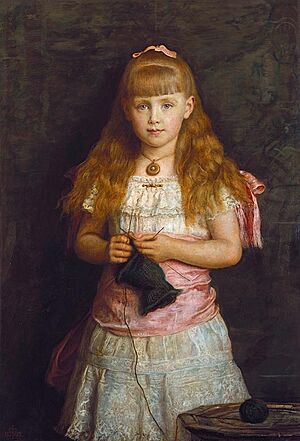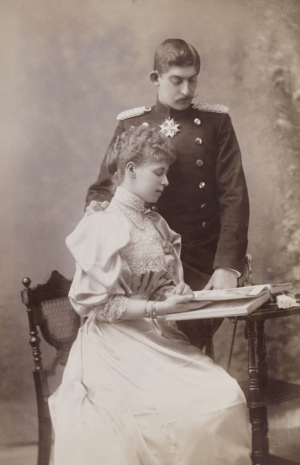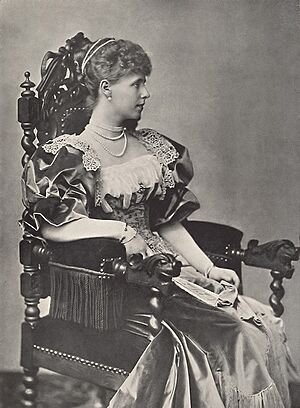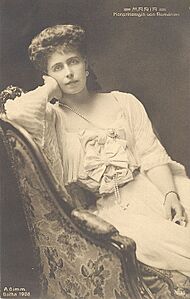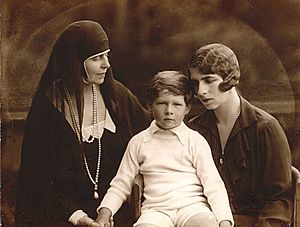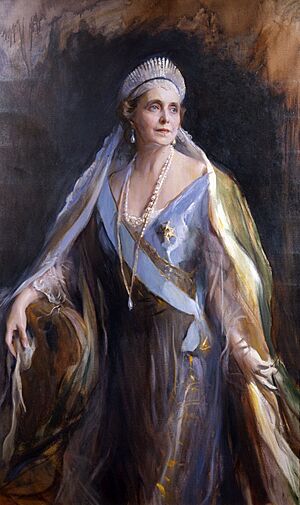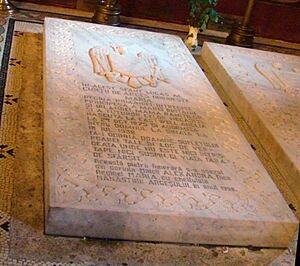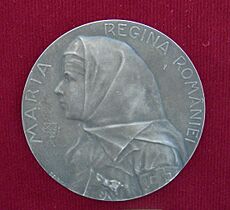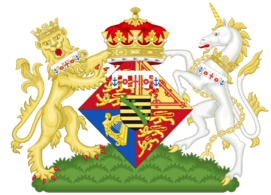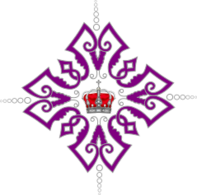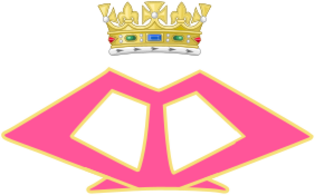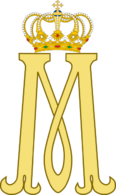Marie of Romania facts for kids
Quick facts for kids Marie |
|||||
|---|---|---|---|---|---|
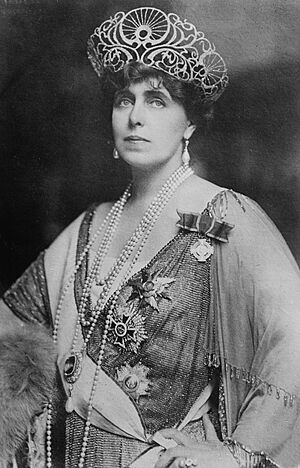 |
|||||
| Queen consort of Romania | |||||
| Tenure | 10 October 1914 – 20 July 1927 | ||||
| Coronation | 15 October 1922 | ||||
| Born | Princess Marie of Edinburgh 29 October 1875 Eastwell Park, Kent, England |
||||
| Died | 18 July 1938 (aged 62) Pelișor Castle, Sinaia, Romania |
||||
| Burial | 24 July 1938 Curtea de Argeș Cathedral |
||||
| Spouse | |||||
| Issue |
|
||||
|
|||||
| House | Saxe-Coburg and Gotha | ||||
| Father | Alfred, Duke of Saxe-Coburg and Gotha | ||||
| Mother | Maria Alexandrovna of Russia | ||||
| Signature | |||||
Marie (born Princess Marie Alexandra Victoria of Edinburgh; 29 October 1875 – 18 July 1938) was the last queen of Romania. She was the wife of King Ferdinand I.
Marie was born into the British royal family. Her parents were Prince Alfred, Duke of Edinburgh and Grand Duchess Maria Alexandrovna of Russia. Marie spent her early years in England, Malta, and Coburg. In 1892, she was chosen to marry Ferdinand, who was then the Crown Prince of Romania.
Marie became Crown Princess in 1893 and was very popular with the Romanian people. When World War I began, she encouraged Ferdinand to join the Triple Entente against Germany. Romania entered the war in 1916. During the war, Marie and her daughters worked as nurses in military hospitals. They cared for wounded soldiers and those sick with cholera.
After the war, in 1918, several regions like Transylvania joined the Old Kingdom. Marie became queen of Greater Romania. She went to the Paris Peace Conference of 1919 to help Romania gain international recognition. In 1922, she and Ferdinand were crowned in Alba Iulia. This grand ceremony showed their role as leaders of a united country.
As queen, Marie was well-liked in Romania and abroad. In 1926, she visited the United States with her children, Nicholas and Ileana. They were welcomed with excitement. Soon after returning, Ferdinand became very ill and passed away. Marie became the queen dowager. Her eldest son, Carol, later took the throne from his own son, King Michael. Carol tried to reduce Marie's popularity. Marie then spent her time in the countryside or at her summer home, Balchik Palace, by the Black Sea. She fell ill in 1937 and died the next year.
Marie is remembered for her work as a nurse and for her many writings, including her autobiography. After Romania became a People's Republic, Marie was seen as a symbol of patriotism.
Contents
Early Life and Family (1875–1893)
Birth and Childhood
Marie was born at Eastwell Park in Kent, England, on 29 October 1875. She was the second child of Prince Alfred, Duke of Edinburgh, and Grand Duchess Maria Alexandrovna of Russia. Her father was the son of Queen Victoria. Her mother was the daughter of Emperor Alexander II of Russia. Marie was named Marie Alexandra Victoria, but her family called her "Missy."
Her baptism took place at Windsor Castle on 15 December 1875. Her godparents included her grandmothers and aunts and uncles from royal families.
Marie and her siblings spent most of their early life at Eastwell Park. Their father was often away because of his work in the British Royal Navy. Their mother, the Duchess, managed their lives. Marie was closest to her sister, Victoria Melita. The children were raised in the Anglican faith.
The Duchess of Edinburgh believed in keeping children and adults separate. Marie wished her mother had allowed them to talk more like equals. The Duchess was independent and important in her children's lives. Marie and her sisters learned French, but they did not like it. Their mother did not focus much on their education, thinking they were not very talented. However, the girls did inherit Queen Victoria's skill in painting and drawing.
The Duke and Duchess often hosted royal family members at Eastwell Park. In 1885, Marie and Victoria Melita were bridesmaids at their aunt Beatrice's wedding. Marie played with her Russian cousins, including Grand Dukes Nicholas and Xenia.
Life in Malta and Coburg
In 1886, when Marie was eleven, her family moved to Malta. Her father became commander of the Mediterranean Fleet. Marie later called her time in Malta "the happiest memory of my existence." She enjoyed riding horses and exploring the island.
The Duke of Edinburgh was set to inherit the Duchy of Saxe-Coburg and Gotha. So, in 1889, the family moved to Coburg, Germany. Marie felt this was the end of her carefree childhood. Her mother, who liked German culture, hired a German governess. The princesses' education expanded to include more painting and music. They also enjoyed going to the Coburg Theatre.
Marriage to Ferdinand
Marie grew into a "lovely young woman." She was courted by several royal bachelors. King Carol I of Romania was looking for a suitable bride for his nephew, Crown Prince Ferdinand. This was to ensure the royal family continued. Marie's mother suggested Marie meet Ferdinand.
Marie and Ferdinand met at a dinner and got along well. They spoke German. Queen Victoria approved of the match. On 10 January 1893, Marie and Ferdinand were married at Sigmaringen Castle. They had three ceremonies: civil, Catholic (for Ferdinand), and Anglican (for Marie).
After a short honeymoon, they traveled to Romania. Marie was warmly welcomed by the Romanian people. They hoped for a more personal monarchy.
Royal Children
| Name | Birth | Death | Spouse and children |
|---|---|---|---|
| King Carol II of Romania | 15 October 1893 |
4 April 1953 |
Married 1918, Ioana Maria Valentina "Zizi" Lambrino (1898–1953); 1 son (Carol Lambrino) Married 1921, Princess Helen of Greece and Denmark (1896–1982); 1 son (King Michael of Romania) Married 1947, Elena "Magda" Lupescu (died 1977) no issue |
| Queen Elisabeth of Greece | 12 October 1894 |
15 November 1956 |
Married 1921, King George II of Greece (1890–1947) no issue |
| Queen Maria of Yugoslavia | 6 January 1900 |
22 June 1961 |
Married 1922, King Alexander I of Yugoslavia (1888–1934); 3 sons (including King Peter II of Yugoslavia) |
| Prince Nicholas | 18 August 1903 |
9 June 1978 |
Married 1931, Ioana Doletti (1902/9–1963) no issue; Married 1967, Thereza Lisboa Figueira de Mello (1913–1997) no issue |
| Princess Ileana | 5 January 1909 |
21 January 1991 |
Married 1931, Archduke Anton of Austria-Tuscany (1901–1987); 2 sons, 4 daughters Married 1953, Dr. Stefan Issarescu (1906–2002) no issue |
| Prince Mircea | 3 January 1913 |
2 November 1916 |
None |
Marie gave birth to her first child, Prince Carol, in October 1893. She later had five more children: Princess Elisabeth (1894), Princess Maria (1900), Prince Nicholas (1903), Princess Ileana (1909), and Prince Mircea (1913).
King Carol and Queen Elisabeth took charge of raising Prince Carol and Princess Elisabeth. Marie loved her children but found it hard to discipline them. The royal children were educated at home, not in schools. This meant they missed out on some social learning.
Crown Princess of Romania (1893–1914)
Adjusting to Royal Life
Marie found it difficult to adjust to life in Romania at first. She disliked the strict atmosphere of the royal court. She felt she was "imported to be trimmed, educated, cut down and trained." Marie wrote that she often felt lonely in her "heavy German rooms."
Marie quickly learned to speak the Romanian language. She followed her mother's advice to dress well and respect Orthodox traditions. King Carol advised Marie and Ferdinand to keep a small circle of friends. Marie felt her family circle was too small, including only the King and Ferdinand.
In 1896, Marie and Ferdinand moved to Cotroceni Palace. Marie added her own designs to the palace. The next year, Ferdinand became very ill with typhoid fever. Marie was very worried. The whole family hoped he would recover, as he was the heir. He did recover, and they went to Sinaia to rest.
Marie was known for her beauty and lively personality. She was rumored to have romantic interests outside her marriage.
In 1903, Ferdinand and Marie opened Pelișor Castle in Sinaia. King Carol had built this Art Nouveau castle for them. Marie later learned about the harsh ways the 1907 Romanian Peasants' Revolt was stopped. After this, she often wore folk costumes, starting a fashion trend.
Balkan War and Succession
In 1913, the Second Balkan War began. Romania joined the war. This war also brought a cholera epidemic. Marie saw this as a turning point in her life. She helped in hospitals, caring for the sick. These experiences prepared her for World War I. After the war, Romania gained Southern Dobrudja, including the town of Balchik. Marie loved Balchik and later built her summer home there, called The Quiet Nest.
On 28 June 1914, Archduke Franz Ferdinand of Austria was assassinated. This event shocked Marie and her family. On 28 July, Austria-Hungary declared war, starting World War I. King Carol wanted Romania to support Germany. However, a council decided against it. Carol's health worsened, and he died on 10 October 1914. Ferdinand then became king.
Queen of Romania (1914–1927)
Leading During World War I
On 11 October 1914, Marie and Ferdinand were crowned King and Queen. Marie was very popular. She had a strong influence on Ferdinand and the court. She encouraged Ferdinand to join the war on the side of the Triple Entente (Russia, France, and Britain). Marie felt this was best for Romania, partly because of her British background.

Ferdinand agreed to Marie's pleas. Romania signed a treaty with the Entente on 17 August 1916. On 27 August, Romania declared war on Austria-Hungary. Marie was deeply involved in helping the Romanian Red Cross. She visited hospitals every day.
On 2 November 1916, Marie's youngest son, Prince Mircea, died from typhoid fever. Marie was heartbroken. When Bucharest fell to Austrian troops, the royal court moved to Iași, in the Moldavia region. Marie continued to work as a nurse there. She would go to the train station to receive injured soldiers and take them to the hospital.
After the Russian Revolution in 1917, Romania was surrounded by enemies. Ferdinand signed a truce. Marie strongly opposed signing the Treaty of Bucharest, which was unfavorable to Romania. She was called "truly the only man in Romania" for her strong stance. The war ended with the Armistice with Germany on 11 November 1918.
Uniting Greater Romania
The idea of a "Greater Romania" had been a dream for many Romanians. In 1918, Bessarabia and Bukovina voted to unite with Romania. A large meeting took place in Alba Iulia on 1 December 1918. There, the union of Transylvania with the Old Kingdom was declared. Marie was thrilled, writing that the dream of România Mare was becoming real.
Ferdinand and Marie returned to Bucharest to a joyful welcome. Allied troops joined the celebrations. Marie was happy to see the Entente forces in Romania. Around this time, Marie became sick with the Spanish flu.
Advocating at the Paris Peace Conference
Romania had been on the winning side of the war. However, the Romanian delegation at the Paris Peace Conference, 1919 faced difficulties. The French Prime Minister was hesitant to overlook some past actions. To solve this, it was suggested that Marie should go to the conference. The Queen was excited about this chance.
Marie arrived in Paris on 6 March 1919. She was immediately popular with the French people because of her bravery during the war. She met many important political figures. She also visited her son Nicky, who was at school in England. Marie was very happy to be back in England.
After her visit to England, Marie returned to Paris. Crowds gathered to see the "exotic" Queen of Romania. American President Woodrow Wilson was not easily impressed by Marie. Marie surprised many officials by leading negotiations herself. She later said, "Never mind, you'll all just have to get used to accepting me with the faults of my virtues." Marie left Paris with much support for Romania. Later that year, the conference recognized Greater Romania. This doubled the size of Ferdinand and Marie's kingdom.
Royal Marriages and Diplomatic Tours
In 1920, Marie's eldest daughter, Princess Elisabeth, became engaged to Prince George of Greece. Marie was happy about this marriage. The next year, Crown Prince Carol married Princess Helen. Marie was pleased, as she had worried about Carol's previous relationships.
In 1922, Marie's second daughter, "Mignon," married Alexander I of Serbia. Marie was delighted when her grandsons, Prince Michael of Romania and Prince Peter of Yugoslavia, were born. These births seemed to strengthen her family's place in Europe. Marie never forced her children to marry.
In 1924, Ferdinand and Marie went on a diplomatic tour of France, Switzerland, Belgium, and the United Kingdom. In England, King George V welcomed her warmly. He said that Marie was "British born." Marie wrote that it was a "great day" to return to her own country as Queen. These visits showed the respect Romania had gained after World War I.
Coronation Ceremony
Marie and Ferdinand's coronation took place in Alba Iulia. This city was important in Romanian history. An Orthodox cathedral was built for the coronation. Special jewelry and clothing were made for the event. Marie's crown was designed in the Art Nouveau style. It was made of Transylvanian gold and inspired by an old Romanian queen's crown.
Many important guests attended the coronation. These included Marie's sister, the Duke of York, and French generals. The ceremony was led by the Metropolitan of All Romania. Ferdinand, who was Catholic, crowned himself first. Then, he crowned Marie, who knelt before him. Cannons fired to mark the moment the first King and Queen of Greater Romania were crowned. A large feast was held for over 20,000 peasants. The next day, Ferdinand and Marie entered Bucharest in triumph. In 1926, Marie joined the Romanian Orthodox Church, wanting to feel closer to her people.
Visit to America
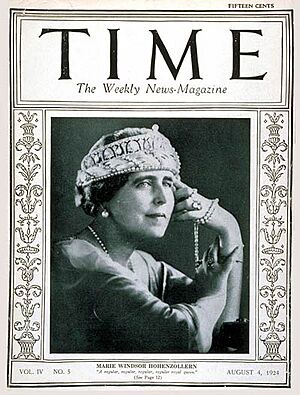
The Maryhill Museum of Art in Washington was meant to be a mansion. But it was turned into a museum. It was to be dedicated in 1926. Marie agreed to come to America for the dedication. She saw the trip as a chance to "see the country, meet the people and put Romania on the map." She traveled by ship and arrived in New York on 18 October 1926. Her children, Prince Nicholas and Princess Ileana, were with her.
|
Oh, life is a glorious cycle of song, |
| Dorothy Parker, 1927 |
Marie was greeted with great excitement in New York. People were eager to see the "exotic" Queen of Romania. She was also popular among women who supported equal rights.
Marie, Nicholas, and Ileana visited several cities, including Philadelphia. They were very popular everywhere they went. At the White House, the official dinner was short. Before leaving, Marie received a special armored car. On 24 November, Marie and her children left from New York Harbor.
Marie loved her visit to America. She wrote in her diaries that she wished to return. She felt a "love for America" that would "beautify my life and thoughts."
Later Years (1927–1938)
Widowhood and Challenges
Prince Carol, Marie's eldest son, gave up his right to the throne in 1926. His young son, Prince Michael, was named the heir. A council was set up to rule until Michael was old enough. Marie and Ferdinand worried about leaving the country to a five-year-old. They feared losing the lands gained in World War I.
When Marie returned from America, Ferdinand was very ill. He died on 20 July 1927, in Marie's arms. Michael became king, and the council took over.
In 1928, Carol tried to return to Romania. He was stopped by English authorities. Marie apologized to King George V for her son's actions. Carol later divorced Princess Helen. Marie's popularity was affected during Michael's reign. She was accused of plotting a coup after she refused to join the regency council.
Princess Ileana's marriage was also discussed. She eventually married Archduke Anton of Austria–Tuscany in 1931.
Carol II's Reign and Marie's Faith
On 6 June 1930, Carol returned to Bucharest and took the throne from his son, becoming King Carol II. Marie was initially relieved. However, Carol refused to listen to his mother's advice. He never sought her counsel, creating a distance between them.
Marie found comfort in the Baháʼí Faith. She was drawn to the idea of all humanity uniting under one faith. She corresponded with Shoghi Effendi, the head of the Faith. She also made public statements promoting the teachings of Baháʼu'lláh. This led Baháʼís to see her as the first royal to follow their religion.
In 1931, Prince Nicholas married a divorced woman, Ioana Doletti. Marie strongly disapproved. She felt hurt by Ioana's attempts to keep Nicholas from his mother. Marie blamed herself for not raising her sons properly. She refused to meet Carol's mistress, Magda Lupescu.
Opposition to King Carol grew. The Iron Guard, a group supported by Benito Mussolini and Adolf Hitler, became strong. After a political leader was assassinated, Carol's popularity dropped. To avoid danger, Carol had Marie attend the annual independence parade. This was her last public appearance.
After the parade, Carol tried to reduce his mother's popularity and push her out of the country. Marie did not leave. She retreated to Bran Castle, which she had received as a gift. She also spent time at Balchik, where she had built a palace and a small chapel. She visited Ileana and her children in Austria.
Final Illness and Passing
In the summer of 1937, Marie became ill. She was very weak. In February 1938, she went to a sanatorium in Italy to recover. Her son Nicholas and his wife visited her there. Princess Helen also visited after many years. Marie was later moved to a sanatorium in Dresden.
As she grew weaker, Marie asked to be taken back to Romania to die. She returned by train to Pelișor Castle. Marie passed away on 18 July 1938. Her two eldest children, Carol and Elisabeth, were with her.
Two days later, Marie's body was brought to Bucharest. She lay in state at Cotroceni Palace. Thousands of people came to pay their respects. Her funeral procession went to Curtea de Argeș Monastery, where she was buried.
Marie's heart was placed in a small golden casket, as she wished. It was buried in her chapel in Balchik. In 1940, when Balchik was given to Bulgaria, her heart was moved to Bran Castle. There, Ileana built a chapel to house it.
Marie was the last queen consort of Romania. She was one of Queen Victoria's granddaughters who remained a queen after World War I.
Legacy and Influence
A Prolific Author
Marie published 34 books and short stories during her life. Her aunt, Queen Elisabeth, encouraged her to write. Her first book, The Lily of Life, was a fairy tale published in 1912. Her book My Country (1916) aimed to gain support for Romania during the war.
Her autobiography, The Story of My Life, was published in three volumes between 1934 and 1935. It was praised for its historical value and insights.
Marie started keeping a daily diary in August 1916, when Romania entered World War I. She wrote entries almost every day. Many volumes of her diaries have been published.
Public Image and Recognition
Even before becoming queen, Marie was known as "one of the best-looking and richest princesses in Europe." She was known for her talents in horse-riding, writing, painting, sculpting, and dancing.
During Romania's time under Communist rule, Marie was sometimes criticized. But later, her good qualities were recognized. In 1968, the chapel holding Marie's heart was disturbed. The heart was moved to Bran Castle and then to the National Museum of Romanian History in Bucharest. In 2015, the casket with her heart was placed in the room where she died at Pelișor Castle.
In Romania, Marie is called Mama Răniților ("Mother of the Wounded") or simply "Regina Maria" (Queen Marie). In other countries, she is known as the "Soldier Queen." She was also called "the mother-in-law of the Balkans" because her children married into ruling families in the region.
A bronze statue of Marie was unveiled in Balchik in 1933. It was later moved to Constanța. In 2018, a statue of Queen Marie was unveiled in Ashford, Kent, England, near her birthplace. A film called Queen Marie was made about her role in the Paris Peace Conference.
Personal Treasures
Many of Marie's personal items are displayed at Bran Castle, which is now a museum. In 2009, these items were moved to a nearby building, Vama Medievală, also open to visitors.
The Maryhill Museum of Art has a permanent exhibit called "Marie, Queen of Romania." It includes her coronation gown, a copy of her crown, and jewelry.
The Queen Marie of Romania Sapphire is a famous jewel named after her. It is a large, egg-shaped sapphire that she bought in 1921. She wore it at her coronation and in portraits. When she visited the United States, people were amazed by its size.
Titles, Styles, Honours and Arms
Titles and Styles
- 29 October 1875 – 10 January 1893: Her Royal Highness Princess Marie of Edinburgh
- 10 January 1893 – 10 October 1914: Her Royal Highness The Crown Princess of Romania
- 10 October 1914 – 20 July 1927: Her Majesty The Queen of Romania
- 20 July 1927 – 18 July 1938: Her Majesty Queen Marie of Romania
Honours
Marie received many honors from Romania and other countries:
 United Kingdom:
United Kingdom:
- CI: Companion of the Crown of India, 11 December 1893
- RRC: Member of the Decoration of the Royal Red Cross
- VA: Royal Order of Victoria and Albert, 2nd Class
- DStJ: Lady of Justice of St. John
- GCVO: Dame Grand Cross of the Royal Victorian Order


 Ernestine duchies: Dame, Special Class of the Decoration of Honour of the Saxe-Ernestine
Ernestine duchies: Dame, Special Class of the Decoration of Honour of the Saxe-Ernestine Kingdom of Romania:
Kingdom of Romania:
- Knight Grand Cross of the Order of the Crown
- Knight Grand Cross of the Order of Carol I, with Collar, 1906
- Knight Grand Cross of the Order of Ferdinand I, with Collar, 1930

 Austria-Hungary: Grand Cross of the Order of Elizabeth, 1913
Austria-Hungary: Grand Cross of the Order of Elizabeth, 1913 France:
France:
- Grand Cross of the Legion of Honour, March 1919
- Médaille militaire
 Grand Duchy of Hesse: Dame of the Golden Lion, 1 May 1896
Grand Duchy of Hesse: Dame of the Golden Lion, 1 May 1896 Kingdom of Italy: Grand Cross of the Crown of Italy
Kingdom of Italy: Grand Cross of the Crown of Italy Kingdom of Portugal: Dame of the Order of Queen Saint Isabel
Kingdom of Portugal: Dame of the Order of Queen Saint Isabel Russian Empire: Grand Cross of St. Catherine, 1896
Russian Empire: Grand Cross of St. Catherine, 1896 Spain: Dame of the Order of Queen Maria Luisa, 1909
Spain: Dame of the Order of Queen Maria Luisa, 1909 Kingdom of Yugoslavia: Grand Cross of St. Sava
Kingdom of Yugoslavia: Grand Cross of St. Sava
Arms
-
Marie's coat of arms as a British princess
Written Works
Books
- The Lily of Life (1912)
- The Dreamer of Dreams (1913)
- Ilderim (1915)
- Four Seasons. Out of a Man’s Life (1915)
- The Naughty Queen (1916)
- The Stealers of Light. A legend (1916)
- My Country (1916); enlarged as The Country That I Love: An Exile's Memories (1925)
- Roumania Yesterday and To-day, by Winifred Gordon (1918) [1st chapter by Queen Marie]
- The Story of Naughty Kildeen (1922)
- Ode to Roumania (1923)
- Why?: A Story of Great Longing (1923)
- The Queen of Roumania's Fairy Book (1925)
- The Voice on the Mountain: A Story for Those Who Understand (1926)
- The Lost Princess: A Fairy Tale (1927)
- The Magic Doll of Roumania (1929)
- The Story of My Life (3 vol., 1934-1935)
- Masks (1937)
- Later Chapters of My Life: The Lost Journal of Queen Marie of Romania (2004)
Short Stories
- "The Serpents' Isle", The Lady's Realm, March 1897
- "The Siege of Widin", The Lady's Realm, July 1898
- "Lulaloo", Good Housekeeping, March 1925
Poems
- "A Robin Redbreast’s Carol", The Lady's Realm, January 1903
Songs
- "Byzantine Princess Song" (1933)
Nonfiction
- "What the River Says", The Lady's Realm, November 1899
- "Romantic Rumania", The Saturday Evening Post, 7 December 1918
- "A Queen Looks at Life", North American Newspaper Alliance, June 1925 [syndicated series]
- "A Queen Talks About Love", Cosmopolitan, September 1925
- "The Intimate Thoughts of a Queen Facing Fifty", Cosmopolitan, October 1925
- "Foreword", Art and Archeology, January 1926
- "At Grand-Mama’s Court", McCall's, March 1926
- "My Impressions of America", North American Newspaper Alliance, 21 October – 4 December 1926 [14-part syndicated series]
- "The Story of My Life", The Saturday Evening Post, 16 December 1933 - 3 February 1934 [8 parts]
- "My Life as a Crown Princess", The Saturday Evening Post, 14 April – 16 June 1934 [8 parts; not in 12 May 9 June]
- "My Mission: I. In Paris", The Cornhill Magazine, October 1939
- "My Mission: II. At Buckingham Palace", The Cornhill Magazine, November 1939
- "My Mission: III. Paris Again", The Cornhill Magazine, December 1939
Letters
- A Biographer's Notebook, by Hector Bolitho (1950) [includes Queen Marie's letters to her "American friend"]
- Queen Mary of Romania: Letters to Her King (2015)
- Queen Marie of Romania: Letters to Her Mother (2 vol., 2016)



